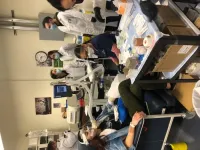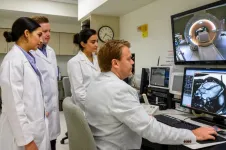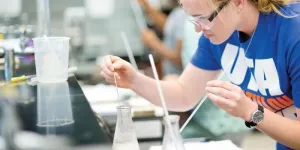(Press-News.org) As a student competing in track and field at his Parlier high school, Robert Leija was obsessed with how to improve his performance and, in particular, prevent the buildup of lactic acid in his muscles during training. Like many athletes, he blamed it for the performance fatigue and muscle soreness he experienced after intense workouts.
But as a kinesiology student at Fresno State, he was handed an out-of-print textbook that told him he had it all wrong. Lactate wasn't a danger sign that athletes had depleted their body's supply of oxygen, but likely a normal product of the metabolic activity required to fuel the muscles during sustained exercise.
Now, as a graduate student in the University of California, Berkeley, laboratory of the scientist who wrote that textbook, George Brooks, his research is providing a much clearer picture of lactate's role in the body, further refuting the notion that lactate is a sign of oxygen deprivation in the muscles.
In a paper published in February in the journal Nature Metabolism, Leija, Brooks and their colleagues showed conclusively that lactate is produced normally in humans after ingestion of carbohydrates. Lactate rapidly enters the bloodstream, even before glucose shows up. Far from being a toxic byproduct to be eliminated during hard exercise, dietary glucose is converted so rapidly to lactate that it preempts or shares top billing with glucose as the two main carbon-energy carriers in the body.
The results show that the rapid conversion of glucose to lactate, starting initially in the intestines, is a way for the body to deal with a sudden dose of carbohydrates. Lactate, working with insulin, buffers the appearance of dietary glucose in the blood.
"Instead of a big glucose surge, we have a lactate and glucose surge after eating," said Brooks, a UC Berkeley professor of integrative biology. "And the more of it that is converted into lactate from glucose, the better it is to manage glucose. Lactate is a carbohydrate buffer."
Brooks and his colleagues had earlier shown this to be true during intense exercise. The new study confirms that lactate plays the same role during normal non-exercise activity and resting.
"It's evidence to show that lactate shouldn't be associated with anaerobic metabolism — that is oxygen-limited metabolism. It's just a normal response to consuming carbohydrates or to exercise," Leija said. "In exercise, lactate is utilized as the dominant fuel source. That's why your blood lactate increases as you exercise a little harder. It's not that you're making it as a waste product. It's getting into the blood because it needs to go to tissues that need it to continue their physiological performance."
Glucose tolerance
The study was conducted on 15 healthy, physically active young adults — eight women and seven men — as part of a larger NIH-funded study to determine how well people switch from fat to carbohydrate metabolism as they age. The volunteers were asked to fast overnight (12 hours) to deplete their carbohydrate and glycogen stores so that they were getting energy primarily by breaking down fats into fatty acids and using them to power basic bodily functions.
They then drank 75 grams of glucose, a rapidly absorbed sugar, to stimulate a switchover from fatty acid to carbohydrate metabolism. This is similar to the glucose tolerance test used to diagnose diabetes and is commonly given to pregnant women to screen for gestational diabetes.
Brooks' study differed from previous similar studies in that he and his colleagues, including Leija, closely monitored the volunteers' blood lactate levels over a two-hour period following ingestion of the glucose, and periodically measured the ratio of oxygen and carbon dioxide in their breath, which indicates the proportion of fatty acids versus carbohydrates being burned.
In order to calculate the amount of lactate that entered the blood compared to glucose, they infused lactate and glucose tracers — lactate labeled with a stable, non-radioactive isotope, carbon-13, and glucose labeled with deuterium — for 90 minutes beforehand to bring the levels of labeled lactate and glucose in the blood to between 1% and 2%. The dilution of the labeled lactate and glucose by incoming, unlabeled dietary glucose allowed them to establish the kinetics, that is, the appearance, disappearance and clearance of blood lactate and glucose. Most such experiments measure static venous blood concentration, which provides little information about glucose and lactate kinetics.
Sampling of arterialized blood was also key to success of the study, Leija said. That allowed the researchers to see what happened in the gut. Typically, a forearm vein is used to sample blood 30 minutes after a glucose challenge, but that sampling yields muddled results.
The researchers found that the volunteers began converting the dietary glucose into lactate before it even left the intestines. Levels of lactate began rising in arterial blood a mere five minutes after the meal, while glucose, often touted as the energy currency of the body, only showed up in the bloodstream 15 to 30 minutes after glucose ingestion.
"The first carbohydrate after a glucose meal gets into the blood as lactate because that’s what intestinal cells do and because most of the glucose is captured by the liver before it is released into the blood for the muscles, where glucose is going to be converted to lactate," Brooks said. "We could see that because of lactate clearance and oxidation and because carbon-13 from the lactate tracer appeared in blood glucose. This shows that lactate is just a major energy highway for distributing carbohydrate — carbon energy flux."
The lactate shuttle
Brooks has conducted human and animal studies for more than 50 years to investigate the role of lactate in the body, each study providing more evidence that it's not a toxic byproduct of oxygen-limited, anaerobic metabolism, which does not happen in the human body, he said. That assumption, however, has colored the way athletes as well as physicians have looked at lactate. Many physicians still perceive high levels of lactate — often incorrectly called lactic acid — in the blood as a symptom of illness that needs to be fixed with supplemental oxygen or drugs.
"Measuring lactate is one of the major things that sports medicine practitioners do. And now we understand what's happening," Brooks said. "Athletes are producing lactate all the time and clearing it all the time. And when they get to the point where they can't clear it, mostly by oxidation and making it into glucose, we know the person can't persist very long.
"I think this is so revolutionary. But it's really confusing to people. What was bad now is good. All the books are wrong."
Except for Brooks' textbook, "Exercise Physiology: Human Bioenergetics and Its Applications." Originally written in 1984 with Thomas Fahey, it's now in its 5th edition. Text for the 6th edition is already being uploaded to the publisher.
"When I read through Dr. Brooks' 1984 book it was a complete mind blow to me, to be honest," Leija said. "I had always associated lactic acid with exercising so hard that I was running out of oxygen and I wasn't putting anything together in terms of physiology. Then it started to make a lot more sense."
In his book, Brooks coined the term “lactate shuttle” to describe the body's metabolic feedback loop in which lactate is the intermediary sustaining most if not all tissues and organs.
He has showed, for example, that in many tissues, lactate is preferred as a fuel over glucose. During intense activity, the muscle mitochondria burn it preferentially and even shut off glucose and fatty acid fuel use. Brooks used tracers to show that human skeletal muscle, heart muscle and the brain prefer lactate to glucose as fuel and run more strongly on lactate. Lactate also signals fat tissue to stop breaking down fat for fuel.
One gap in these studies was what happens during normal non-exercise activity and resting. The current study fills that gap and supports the idea that when lactate levels in the blood remain high, it is a signal that something is disrupting the lactate shuttle cycle, not that lactate itself is harming the body.
"It's really informative about various medical conditions," Brooks said. "I think what's significant about the current result is that it's just not a muscle thing. It starts with dietary carbohydrate. This was a missing piece in the puzzle."
The recent study is part of Leija's Ph.D. thesis, after which he hopes to conduct further research on the metabolic role of lactate.
"Since before college I would read physiology books trying to improve my training and I would see all these science terms that I kind of ignored back then because I was just looking for, How can I get faster? How can I run longer?" Leija said. "But now, wow, it ended up helping me out indirectly. Still to this day, there's so much I think that's left to be uncovered about it."
Other coauthors of the study are graduate students Casey Curl, Jose Arevalo, Adam Osmond and Justin Duong, Melvin Huie, MD, a UC Berkeley graduate affiliated with Brooks' Exercise Physiology Laboratory, and Umesh Masharani, MD, an endocrinologist with UC San Francisco's Diabetes Center.
END
Far from toxic, lactate rivals glucose as body's major fuel after a carbohydrate meal
Research challenges perception by many athletes and physicians that high lactate levels are bad
2024-05-14
ELSE PRESS RELEASES FROM THIS DATE:
AI for more caring institutions
2024-05-14
More and more public services — such as affordable housing, public school matching and child welfare — are relying on algorithms to make decisions and allocate resources. So far, much of the work that has gone into designing these systems has focused on workers’ experiences using them or communities’ perceptions of them.
But what about the actual impact of these programs have on people, especially when the decisions the systems make lead to denial of services? Can you design algorithms to help people make sense of and ...
Astronomers spot a giant planet that is as light as cotton candy
2024-05-14
Astronomers at MIT, the University of Liège in Belgium, and elsewhere have discovered a huge, fluffy oddball of a planet orbiting a distant star in our Milky Way galaxy. The discovery, reported today in the journal Nature Astronomy, is a promising key to the mystery of how such giant, super-light planets form.
The new planet, named WASP-193b, appears to dwarf Jupiter in size, yet it is a fraction of its density. The scientists found that the gas giant is 50 percent bigger than Jupiter, and about a tenth as dense — an extremely low density, comparable to that of cotton candy.
WASP-193b is the second lightest planet discovered to date, ...
Sleep experts to convene in Houston for SLEEP 2024 annual meeting
2024-05-14
DARIEN, IL – Leading sleep and circadian scientists, sleep clinicians, and industry innovators will gather June 2-5 in Houston at SLEEP 2024, the 38th annual meeting of the Associated Professional Sleep Societies, LLC. Thousands of sleep professionals will connect, explore, and grow at the world’s premier clinical and scientific sleep meeting, held jointly by the American Academy of Sleep Medicine and the Sleep Research Society.
“Every year, SLEEP brings together the world’s ...
Rice’s Mamouras wins NSF CAREER Award
2024-05-14
HOUSTON – (May 14, 2024) – As the Internet of Things (IoT) grows larger and more complex, it becomes increasingly difficult to develop applications.
“A common approach to this problem is to move data from the sensing devices to a central location, such as the cloud, for processing,” said Konstantinos Mamouras, assistant professor of computer science at Rice University. “But this centralized approach underutilizes the small IoT devices at the edge of the network and can overwhelm it due to the large movement of data.”
With his five-year, $547,555 National Science Foundation CAREER Award, Mamouras aims to decentralize the IoT, relieve network congestion and ...
ISS National Lab announces up to $750,000 in funding for technology development in low Earth orbit
2024-05-14
KENNEDY SPACE CENTER (FL), May 14, 2024 – The International Space Station (ISS) National Laboratory is soliciting flight concepts for technology development that would utilize the space-based environment of the orbiting laboratory. This solicitation, “Technology Development and Applied Research Leveraging the ISS National Lab,” is open to a broad range of technology areas, including chemical and material synthesis in space, translational medicine, in-space edge computing, and ISAM (in-space servicing, assembly, and manufacturing). ...
Counterfeit coins can be detected more easily thanks to a novel approach developed at Concordia
2024-05-14
Metal coins may be just about the oldest medium of exchange still in use today, but ensuring their worth requires some of the most state-of-the-art technology available. Counterfeit coins remain a threat to global currencies, with malicious actors flooding markets with fakes. European police broke up a Spain-based criminal ring in late April, demonstrating the issue’s ongoing urgency.
However, no counterfeit is completely detection-proof, no matter how genuine it appears. There are always some tell-tale signals of forgery, even if they are not ...
Professors elected to Academy of Distinguished Scholars
2024-05-14
The University of Texas at Arlington has elected two longtime professors to the Academy of Distinguished Scholars, considered the University’s most prestigious research and scholarship honor.
Ramon Lopez, professor of physics, and Michael D. Nelson, associate professor of kinesiology, are being recognized for their sustained and significant contributions to research and creativity.
“Members of the Academy of Distinguished Scholars exemplify UTA’s commitment to quality research and creative activity,” said Kate C. Miller, vice president of research and innovation. “Mike and Ramon have both ...
UTA biology students receive awards for excellence
2024-05-14
Thirteen undergraduate and graduate students at The University of Texas at Arlington are being honored for excellence in academics, research, mentoring and/or teaching with awards. The awards are a mix of direct applications from students and others where they were nominated by faculty advisors. A committee of biology faculty then voted on the competitive awards.c
“It’s so rewarding to be able to honor the next generation of biologists,” said Melissa Walsh, who chaired the selection committee ...
Making every hair appointment a sound experience #ASA186
2024-05-14
OTTAWA, Ontario, May 14, 2024 – Walking out of a hair salon can have customers feeling brand new, but the noisy environment may have negative effects at the cost of a new “do.” At Image Creators salon in Maryland, owner Silvia Campana along with her employees and customers noticed they had to work hard to understand each other’s words while in the salon, but they couldn’t put their finger on exactly why. In addition to difficulties understanding speech, Campana experienced increased ear pain and tinnitus after long-term exposure to ...
Tennessee teen uses national platform to advocate for CPR and heart health
2024-05-14
DALLAS, May 13, 2024 — The American Heart Association’s National Teen of Impact title offers Gen Z changemakers an influential platform to fight against heart disease to improve health and well-being in communities across the country. This year, Aniston Barnette, a 16-year-old volunteer advocate from Bristol, Tenn., is the 2024 national winner. As a prominent student-athlete, Barnette is supporting the lifesaving mission of the American Heart Association – celebrating one hundred years of lifesaving service – by promoting cardiopulmonary resuscitation (CPR) awareness and education.
After watching family members suffer and die from ...
LAST 30 PRESS RELEASES:
Scientists boost cell "powerhouses" to burn more calories
Automatic label checking: The missing step in making reliable medical AI
Low daily alcohol intake linked to 50% heightened mouth cancer risk in India
American Meteorological Society announces Rick Spinrad as 2026 President-Elect
Biomass-based carbon capture spotlighted in newly released global climate webinar recording
Illuminating invisible nano pollutants: advanced bioimaging tracks the full journey of emerging nanoscale contaminants in living systems
How does age affect recovery from spinal cord injury?
Novel AI tool offers prognosis for patients with head and neck cancer
Fathers’ microplastic exposure tied to their children’s metabolic problems
Research validates laboratory model for studying high-grade serous ovarian cancer
SIR 2026 delivers transformative breakthroughs in minimally invasive medicine to improve patient care
Stem Cell Reports most downloaded papers of 2025 highlight the breadth and impact of stem cell research
Oxford-led study estimates NHS spends around 3% of its primary and secondary care budget on the health impacts of heat and cold in England
A researcher’s long quest leads to a smart composite breakthrough
Urban wild bees act as “microbial sensors” of city health.
New study finds where you live affects recovery after a hip fracture
Forecasting the impact of fully automated vehicle adoption on US road traffic injuries
Alcohol-related hospitalizations from 2016 to 2022
Semaglutide and hospitalizations in patients with obesity and established cardiovascular disease
Researchers ‘listen in’ to embryo-mother interactions during implantation using a culture system replicating the womb lining
How changing your diet could help save the world
How to make AI truly scalable and reliable for real-time traffic assignment?
Beyond fragmented markets: A new framework for efficient and stable ride-pooling
Can shape priors make road perception more reliable for autonomous driving?
AI tracks nearly 100 years of aging research, revealing key trends and gaps
Innovative techniques enable Italy’s first imaging of individual trapped atoms
KIER successfully develops Korea-made “calibration thermoelectric module” for measuring thermoelectric device performance
Diversifying US Midwest farming for stability and resilience
Emphasizing immigrants’ deservingness shifts attitudes
Japanese eels, climate change, and river temperature
[Press-News.org] Far from toxic, lactate rivals glucose as body's major fuel after a carbohydrate mealResearch challenges perception by many athletes and physicians that high lactate levels are bad






